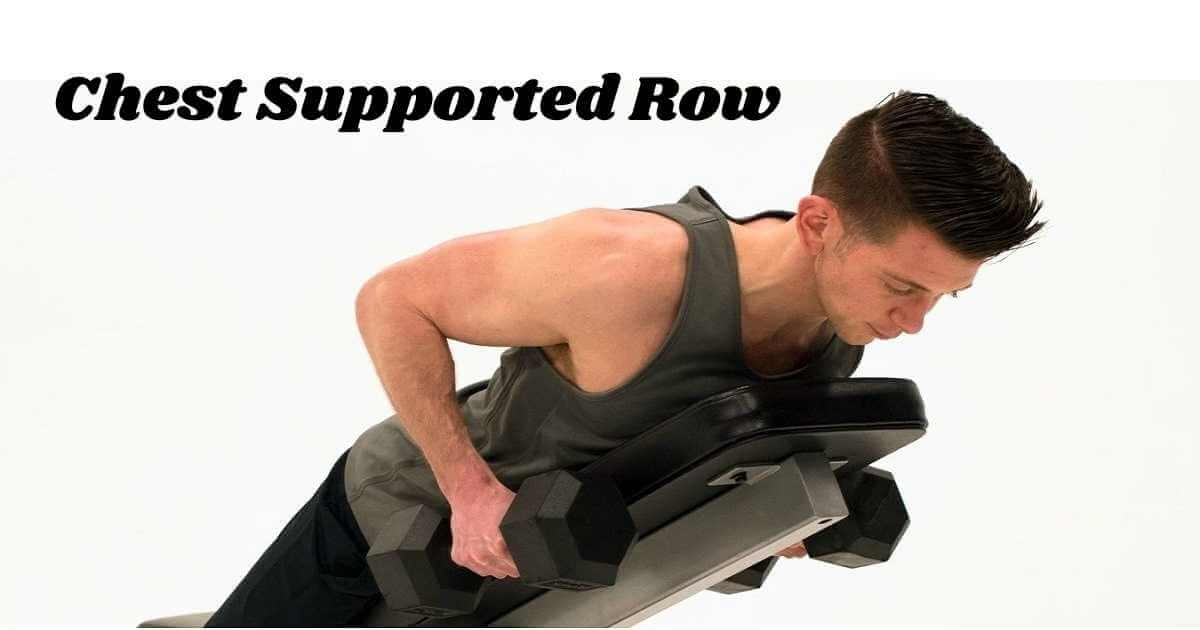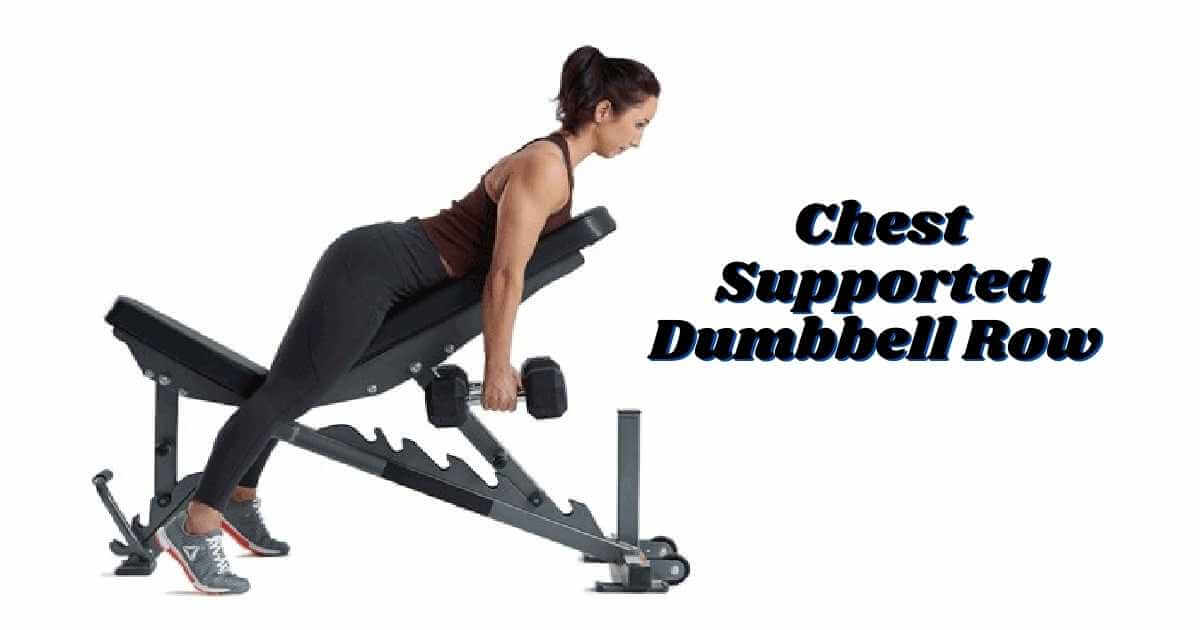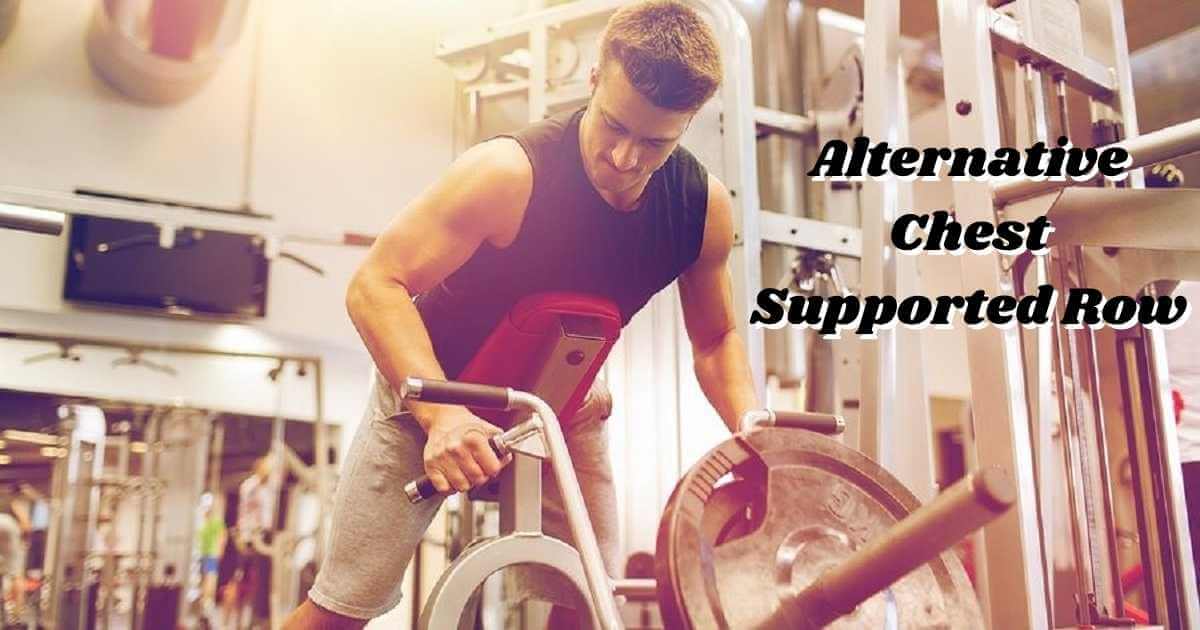A bench and a set of dumbbells are all you need for the chest supported row. Although the name implies that it is a chest exercise, it is a movement that targets the shoulders and back.
This sort of row eliminates the requirement for back and core stability and allows you to row with better form by supporting the front of your body against the bench. You’ll want to keep reading if you’re looking to improve your back and shoulder strength.
What Exactly Is A Chest Supported Row?
Rowing is a popular compound workout. It is made up of a few different joints that move in a wide range of motion. Consequently, it activates a wide range of muscles from all over the body, making it particularly useful for increasing upper-body strength and endurance.
A dumbbell row with your chest supported is a good option. It’s a row where your chest is supported, as the name says. You may eliminate the requirement for your back to stabilize the action by leaning onto a bench with Your upper body. Unlike other rows, such as the bent-over row, your lower back and hamstrings are not used to keep the exercise stable.
This row is significantly more effective for targeting the back muscles since it eliminates the requirement for other forces to stabilize the body during the activity. They’ll undoubtedly get weary, which will aid in the development of muscular mass in this region.

How to Perform the Chest-Supported Dumbbell Row Correctly?
momentum and let you focus on the muscles you want to strengthen. “Maintain your chest throughout the workout,” Braun says.
“As you acquire weight, you will instinctively compensate by elevating your chest.” Keeping your chest against the bench, on the other hand, will prevent you from building momentum and let you focus on the muscles you want to strengthen.

- Place a 45-degree inclination bench on the floor.
- With a pair of dumbbells in hand, approach the bench with your chest toward the angled pad, then lean on it. Place your feet firmly on the ground and extend your arms straight down, palms facing each other. This is where the game begins.
- Bring the dumbbells up to your ribcage by squeezing your shoulder blades together and driving your elbows toward the sky.
- Rep the exercise slowly in the opposite direction for a total of 10 repetitions.
Chest-supported row targeted muscles.
The incline dumbbell row strengthens and develops all of the muscles listed below, allowing you to improve your efficiency with any pulling exercise.
The Latissimus dorsi is a muscle at the back of the body.
The lats are a pair of fan-shaped muscles that attach to your upper arms and span your mid and lower back. They are the biggest muscles in your upper body and your body’s principal pulling muscles. They form a “V” shape in your torso when fully matured.
The Trapezius Muscle Is Located At The Back Of The Neck.
The traps are a kite-shaped muscle that runs from your neck through your midback and out to your shoulders, assisting in the movement and stabilization of your shoulder blades. Upper, middle, and lower fibers may all be found in the human body.
Rhomboids Are A Kind Of Rhombus.
The rhomboids major and minor are a diamond-shaped muscle group in the upper back that runs from the inside border of your shoulder blades to your spine. When you’re pushing or pulling, they’re responsible for lifting your shoulders back and stabilizing them.
Biceps Are A Muscle Group In The Upper Arm.
The biceps are made up of three muscles: the biceps brachii, brachialis, and brachioradialis are responsible for flexing and rotating your forearm.
Who Should Do Chest Supported Rows?
People who want to strengthen their upper back muscles
The dumbbell row with your chest supported is a great way to work your back muscles. This is a good option if you’re looking for an activity that targets the shoulder, forearm, and upper torso muscles. In a similar way as bent-over row motions, most of these muscles are exercised at the same time.

Exercise Enthusiasts With Lower Back Issues
Do you have a lingering lower back problem that prevents you from going to the gym?
The chest-supported row is an excellent workout for staying in shape. Even if you have some fragile areas at the time, you may still train the muscles around your back.
Newcomers To Row Movements
Newcomers to rowing activities may use the incline bench action to improve their performance on more challenging programs. This activity is primarily designed to educate newcomers with rowing motions or to assist athletes in their recovery.
The Advantages Of Row With Your Chest Supported

When it comes to the kind of exercises you may perform for a back workout, the possibilities are almost endless.
While specific back workouts are beneficial in terms of muscular development, they may also have particular hazards.
Rows with your chest supported offer some advantages that make it one of the most excellent back exercises to include in your next training program.
- Low Risk of Injury: Exercises like T-Bar Rows and Bent Over Rows are fantastic for growing muscle, but they put your back in jeopardy while you’re doing them. You may get all of the advantages of the exercise while decreasing the danger of injury by completing a comparable action with the support of a bench against your chest.
- Requires Minimal Equipment: Unlike various back workouts, this one does not need the use of any complicated types of equipment or equipment. All that is necessary to complete the activity is a rack, weights, and a bench, all found in most gyms.
- Excellent for Isolating Back Muscles: Other back exercises, such as bent-over rows, engage secondary muscles like the glutes and hamstrings. The chest supported row maintains your spine in a neutral posture, which reduces the usage of other forces in the activity.
- Excellent Alternative Exercise for Those with Ailments: When it comes to completing various back exercises, many individuals have a history of injuries. Deadlifts, bent-over rows, and T-Bar rows are impossible for anyone with low back difficulties or who has had previous operations. On the other hand, a chest-supported row may be performed by persons of all ages, independent of injury history.
Great Way to Learn From:
Because of poor mechanics or a lack of information, novices often harm themselves early on. If you learn how to execute a chest-supported row correctly, you’ll be less likely to injure yourself later if you move to bent-over rows. Consider it similar to learning to ride a bike without training wheels before removing them.
Getting Ready For The Barbell Supported Chest Row

Although the chest-supported barbell row does not need a lot of equipment. It must be correctly set up to maximize muscular development. For setup, you’ll need the following items:
- Weight plates and an Olympic bar (choose a weight that is light to moderate, to begin with)
- Squat Rack with hooks pointing outwards
- Adjustable bench (optional though practical to begin the movement)
Once you have all of the necessary equipment, start the setup by following these steps:
- Set up your incline bench beside the squat rack at a modest 45-degree inclination angle. Setting the inclination too high can result in an uncomfortable stance, while setting it too low will restrict your range of motion, reducing the exercise’s efficacy.
- Attach the hooks to the exterior of the squat rack at a height that allows you to reach them with your arms at arm’s length. (Note: if you don’t have access to a squat/power rack, you can still complete the exercise provided someone else can help you raise the barbell to start the action.)
- Next, place the incline bench on top of the squat rack, with the court precisely over the barbell’s center. The bar should be precisely in front of your shoulders.
- Lean on the bench with your chest pressed against it.
- To get into position, place your feet on the ground or securely straddle the bench.
- Grasp the bar with either an overhand or an underhand grip, depending on your preference. Changing up your grip position is one way to spice up your training.
- Begin the rowing action by gripping the barbell and slowly and steadily pulling the weight up and down. (It’s worth noting that form is much more essential than weight, so manage the weight rather than swinging it back and forth with poor condition.)
- Try to maintain the rep ranges between 6 and 12 repetitions for muscular growth. Try not to go too heavy throughout the activity and gradually add weight if necessary.
Rowing Exercise with the Chest Supported
The dumbbell row with the chest supported is an excellent workout for developing the mid to upper back and the rear delts. It’s also an excellent alternative for folks who have shoulder problems and can’t do overhead presses, as well as those who want to rehabilitate their shoulders.
Equipment Necessary:
This exercise should be performed using an incline bench and weights. If you don’t have access to an incline bench, a flat bar propped up on a box may be used to provide the same angle.
Level of expertise:
Beginner level
For women who are just getting started with strength training, the chest-supported row may be too advanced in some instances. Beginners may opt to execute this exercise on a chest-supported row machine rather than a dumbbell variety if this is the case.
Intermediate level
The supported chest row is a terrific intermediate lifter choice. You may do this exercise alone, couple it with another upper body pushing exercise as part of a superset, or make it part of a metabolic conditioning circuit. Lifters may change the muscles targeted by altering the elbow body position. If the elbows are kept toward the body, pointing backward, the lats will do most of the effort. Back delts, traps, and rhomboids will need the greatest effort if the elbows are angled out. Intermediate lifters may complete 2-4 sets of 6-12 chest-supported row repetitions.
Advanced level
Negative repetitions with the lowering phase increased to 3-5 seconds. Which eccentrically develops the muscles, is an option for women who are comfortable with this supported dumbbell row variation. You may raise the weight/resistance of fewer sets (2-4+) (3-6). You may further challenge this workout by adding band resistance.
Who Is Not a Candidate for Chest Supported Rows?
People who are experiencing upper back discomfort
Someone who has just returned from a long injury layoff should decide if this is the best course of action for them. People who are unable to complete a bent-over row should generally avoid this workout.
Trainers with built-in upper back support
If you’re a pro with a well-built back, this incline bench action can be pointless for you.
Instead of practicing modest incline bench motions, consider additional advanced exercises to keep your form in shape.
lifters with upper back injury history
If you’ve ever had to deal with an upper back issue, it’s best to avoid chest-supported row exercises. The action focuses more on the muscles in your upper back than on any other part of your body.
People who have had injuries to their shoulder blades, deltoid muscles, or upper back in the past may worsen existing lesions. So, especially with larger weights, it’s a good idea to avoid chest-supported row actions.
Alternative to the Chest Supported Row

Chest-supported rows aren’t the only exercise you may do if you have lower back pain or difficulties.
Aside from the chest-supported row, various more workouts are as helpful. The chest-supported T-Bar row is one of these exercises.
The chest-supported T-Bar row may be found in almost every gym. The bar stays connected because of its fixed construction, which helps to reduce back flexion and avoid lower back damage.
The chest support is usually adjustable, so you may select a comfortable height that allows for a maximum range of motion.
Another benefit of the T-Bar row machine is that it generally comes with several grips, allowing for training variety.
Gym longevity is boosted by decreasing injury risk. You may remain healthy and perform better in the gym for life by completing the chest-supported T-Bar row or chest-supported.
FAQs
What is Chest Supported Row’s purpose?
- Rhomboids
- Trapezius muscles
- Biceps muscles
- Lower back and latissimus dorsi muscles
What’s the best way to do chest-supported rows at home?
- With a stable, inclined angle strong enough to support your body weight, such as a bench or table.
- Get on the bench with your chest first, then do whatever chest-supported row variation you like.
What exactly is a dumbbell row with chest support?
A dumbbell row with your chest supported is a novice or recovery-level workout that focuses your upper back muscles.